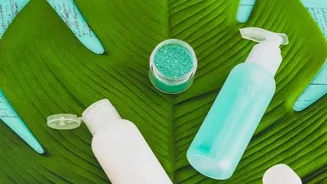Discover why patch testing is crucial for your skin's health. Uncover the secrets to flawless skin. Read more
In our quest for flawless skin and the perfect beauty routine, we are often tempted by dazzling
advertisements and promises of miraculous transformations. New products launch almost daily, each claiming to be the ultimate solution to all our skin woes.
But, before you slather that new cream, serum, or cleanser all over your face, there's one small but crucial step you absolutely shouldn't skip: the patch test.
This simple procedure can save you from a world of skin irritation, allergic reactions ki pareshani and helps you understand how your skin truly reacts to new ingredients. Think of it as a trial run for your skincare, ensuring that your skin is happy and healthy.
Kyunki, ultimately, healthy skin is beautiful skin.
Patch testing: a precaution to prevent skin reactions to products
Patch testing is basically like giving your skin a sneak peek of a new product. It is all about seeing how your skin reacts to a small amount of the product before you apply it to a larger area, like your whole face.
Different people have different skin types, and what works for one person might not work for another. Some people may be allergic to certain ingredients without even knowing it. A patch test helps you identify potential irritants or allergens before they cause widespread problems.
It's a simple precautionary measure that can prevent unnecessary discomfort and save you money in the long run. Imagine spending a fortune on a product only to find out it gives you an itchy rash!
Patch testing crucial for skin health, prevent adverse reactions
Why is patch testing so important, you ask? Well, consider this: your skin is your body's largest organ, and it's constantly exposed to various environmental factors and ingredients. Introducing a new product without testing is like throwing your skin into unknown territory.
Allergic reactions can range from minor redness and itching to more severe symptoms like swelling, blisters, and even difficulty breathing. Severe reactions might even require a visit to the doctor.
Patch testing allows you to minimize the risk of such adverse reactions and protects your skin's health. It's especially important for those with sensitive skin, eczema, or a history of allergic reactions.
Patch testing at home: select skin area, apply product, wait 24-48 hours for reaction
The process of patch testing is surprisingly simple and can be done at home. Start by selecting a small, discreet area of your skin. The inside of your elbow or behind your ear are good choices because these areas are less visible and have thinner skin, making reactions easier to spot.
Clean the area with a gentle cleanser and pat it dry. Apply a small amount of the product to the selected area, making sure it's a thin, even layer. Cover the area with a bandage if necessary to prevent the product from rubbing off.
Now, wait for the recommended time, which is typically 24 to 48 hours. Make sure the site isn't exposed to excess sun or friction that will affect the irritation.
Monitor patch test for reaction signs; wash off if allergic
Over the next 24 to 48 hours, carefully monitor the patch test area for any signs of a reaction. Look out for redness, itching, burning, swelling, or the appearance of small bumps or blisters. If you experience any of these symptoms, wash the product off immediately with mild soap and water.
This indicates that you are likely allergic or sensitive to the product, and you should not use it on a larger area of your body. Even if you have used similar products before, remember that formulations can change, and you might develop an allergy to a specific ingredient over time.
Wait for 48 hours for skin reaction before expanding product use
But what if you don't see any reaction after 48 hours? Does that mean you're in the clear? Generally, yes, it's a good sign but it doesn't guarantee you won't have a delayed reaction. Watch the area for more days.
If your skin appears normal after the waiting period, it's likely safe for you to use the product on a larger area. However, it's always a good idea to introduce new products gradually, one at a time, so that if you do experience a reaction later, you can easily identify the culprit.
Patience is key when it comes to skincare. Remember; slow and steady wins the race to healthy, glowing skin.
Perform a patch test before trying new skincare products
So, the next time you're tempted to try that promising new product, resist the urge to apply it all over your face immediately. Take a moment to perform a patch test. Your skin will thank you for it!











